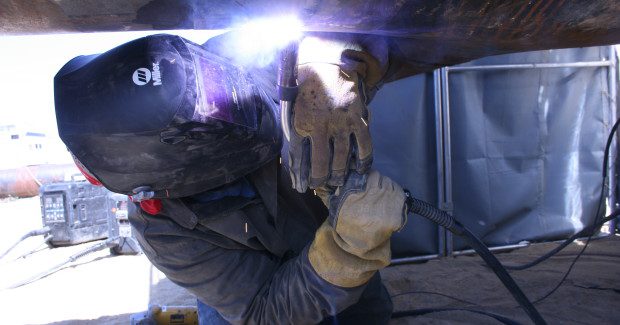Welding with Handsaws vs. Chain Saws
Because labor costs are approximately 80 percent of the true cost of welding in the field while equipment is only about 5 percent, providing welding operators with the most productive tools is among the best ways to reduce labor costs and increase efficiency.
Posted: May 20, 2014
Obviously, there are productivity and efficiency differences between a handsaw and a chain saw. Picturing the differences between those tools helps illustrate the fact that using modern equipment and technology can improve productivity and throughput by a significant amount, while also making the job easier for workers.
Companies and fleet managers should think of welding equipment and technologies in the same way and ask themselves: “When it comes to welding applications, am I supplying operators with handsaws or chain saws?”
There are welding technologies on the market that can improve productivity, quality and safety, all while offering simple setup and ease of use for operators. Some of the features offered in welding systems with these advanced technologies include point-of-use control, push-button welding parameter adjustment up to 200 ft away from the power source, and advanced welding processes that make it easier for operators to achieve code-quality welds, even in challenging jobsite environments.
TECHNOLOGY INNOVATIONS
No matter if a company is welding with Stick, TIG, MIG or Flux-Cored processes, there is equipment and technology available that’s designed to improve productivity, quality and safety.
Innovations such as advanced remote control capabilities and point-of-use welding controls can reduce the need to travel to and from the power source. This optimizes uptime at the weld joint and simplifies process changeover, which in turn helps improve overall weld quality and productivity.
Reducing the trips between the power source and the weld joint also results in a safer workplace or jobsite, since welding operators will have fewer opportunities for trips and falls. This can especially make a difference on expansive jobsites, where welding may take place hundreds of feet from the power source.
Our PipeWorx FieldPro™ system, for example, offers these advanced capabilities and technologies without the need for special control cables, instead using the standard weld cable. This eliminates the hassle and expense of special control cables and reduces clutter on the jobsite.
A demonstration and overview of the capabilities of the PipeWorx FieldPro system.
The system offers a remote that basically allows welding operators to take the capabilities from the front panel of the power supply right to the area where they are actually welding. This technology makes process changeover easier, which eliminates the need to “get by” with less than optimal settings and helps reduce weld defects and associated rework.
A remote specifically optimized for Stick and TIG welding gives operators the ability to remotely change process and polarity, set actual amperage and detect improper connections, all without the need to swap weld cables. Another feeder is specifically designed for traditional and advanced wire processes, offering the ability to weld up to 200 ft away from the power source with no special cables — a much greater distance than cabled solutions allow. The system also saves welding parameters on a memory card for later use. The “plug and play” style of this feeder offers ready-to-weld default parameters for each process, so welding operators can simply select the process, wire type, wire diameter and gas — and start welding.
ADVANCED PROCESSES
Advanced welding processes, such as Pulsed MIG and Modified Short Circuit MIG, are other options for companies and welding operators to consider when they’re looking to improve quality and productivity.
These advanced processes offer a more forgiving weld to help reduce weld failures. Modified Short Circuit MIG helps reduce the necessary training time and makes it easier for a welding operator to complete an x-ray quality weld on the root pass.
The Pulsed MIG process also offers smooth transfer and a controlled arc in an easy-to-use process. The technology can monitor and adjust parameters up to 10,000 times per second to maintain optimum arc conditions.
Both of these advanced welding processes are available in systems with the remote control technologies mentioned above, so welding operators can maximize productivity with the faster advanced processes while also taking advantage of the ability to change processes and parameters at the weld joint with the push of a button.
RETURN ON INVESTMENT
When you break down the true cost of welding in the field, labor is approximately 80 percent of that, while equipment is a much smaller portion, at about 5 percent. Providing welding operators with the most productive tools is among the best ways to reduce labor costs and increase efficiency — benefits that everyone can appreciate.
Advanced welding technologies and processes can provide that return on investment by offering improved productivity, weld quality and safety.















